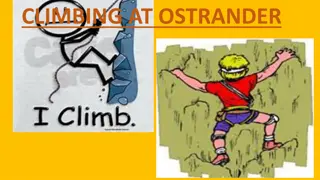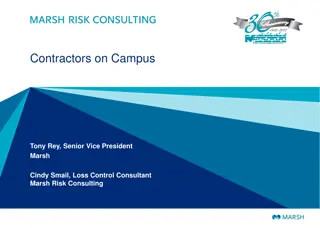Essential Climbing Safety Tips and Techniques
This content provides valuable information on climbing equipment, security measures, belaying techniques, and essential knots for climbers. It emphasizes the importance of safety checks before and during climbing, highlighting key practices to ensure a safe and enjoyable climbing experience. The detailed guide covers topics such as harness checks, knot verification, rope and belay device inspection, belayer responsibilities, and the significance of proper knot tying. Whether you are a beginner or experienced climber, following these safety tips and techniques is crucial for a successful climbing adventure.
Download Presentation

Please find below an Image/Link to download the presentation.
The content on the website is provided AS IS for your information and personal use only. It may not be sold, licensed, or shared on other websites without obtaining consent from the author.If you encounter any issues during the download, it is possible that the publisher has removed the file from their server.
You are allowed to download the files provided on this website for personal or commercial use, subject to the condition that they are used lawfully. All files are the property of their respective owners.
The content on the website is provided AS IS for your information and personal use only. It may not be sold, licensed, or shared on other websites without obtaining consent from the author.
E N D
Presentation Transcript
EQUIPMENT Climbing shoes Climbing harness Climbing ropes
Belay devices Or ATC Climbing carabiners Quickdraws
SECURITY 1. Always Check Harnesses After you've geared up and tied into the rope at the base of a route, always check that both the climber's and belayer's harness buckles are doubled back. Make sure the leg loops are also snug; most harnesses have adjustable leg loops. 2. Always Check Knots Before you start climbing, always double check to make sure that the lead climber's tie-in knot (usually a Figure-8 Follow-Through) is tied correctly and finished with a backup knot. Also check that the rope is threaded through both the waist loop and the leg loops on the harness.
3. Always Check the Rope and Belay Device Before you lead a route, always double check to make sure that the rope is properly threaded through the belay device (especially if it is a GriGri). Also, always make sure that the rope and belay device are attached with a locking carabiner to the belay loop on the belayer's harness. 6. Always Pay Attention When you're belaying, always pay attention to the leader above. He is the one taking the risks of a fall and leading the route. It is smart to never visit with other climbers at the base, talk on a cell phone while you are belaying.
BELAYING The belayer, the person who establishes a belay by holding the rope, turns a climbing rope into a safety tool rather than what the great climber Royal Robbins once called a lethal weapon. Belaying, while sounding rather complicated, is actually an easy climbing skill to learn and to become a good belayer mostly requires lots of practice. Be a Good Safe Belayer Belaying is the most critical part of your climbing safety chain. It s also a part that can go badly wrong with belayer error or inattention. A good and conscientious belayer can and will save your life if you fall. A bad and inattentive belayer can drop you to the ground. Be a good belayer and expect your climbing partner to be the same.
Step 1: Tie a Single Figure-8 Knot The Figure-8 Follow-Through, also called the Flemish Bend and Figure-8 Trace knot, is the most important knot to learn as a climber. This is the best knot to tie the rope into your harness since it is the strongest climbing knot. It is also easy to check visually to make sure it is tied correctly since each side is a clone of the other. You can tell at a glance if it is tied correctly. Climbers use this essential knot to tie into the end of the rope because it won t come untied and only gets tighter when the rope is weighted.
Step 2: How to Tie a Figure-8 Follow- Through Knot After tying the first Figure-8, thread the end of the rope through the harness loop between your leg loops and pass it up through the harness tie-in point on the waist belt (same waist loop that the belay loop is attached to). Snug the Figure-8 against the leg loops. Consult your harness instructions for the exact tie-in points on the climbing harness.
Step 3: How to Tie a Figure-8 Follow- Through Knot for Climbing Retrace the original Figure-8 with the loose end of the climbing rope, carefully following each part of the original knot. Afterwards tighten and dress the knot by neatening the separate parallel strands and making sure they don t cross over each other. You should have a leftover tail of about 18 inches for tying a backup knot. If you don t tie a backup knot, make sure you have a floppy tail of at least 12 inches so the knot will not undo under load.
After retracing the Figure-8, you should have 15 to 20 inches of rope left. Now you will tie a Fisherman s Backup knot. This is not a safety knot but a way to keep the original Figure-8 Follow-Through knot tight. The Fisherman s Backup is the superior backup knot to use because it cinches tight if tied correctly. First make sure you have about 18 free inches of tail left after tying the Figure-8. Wrap the tail rope twice around the climbing rope, then pass the free end through the coils.























